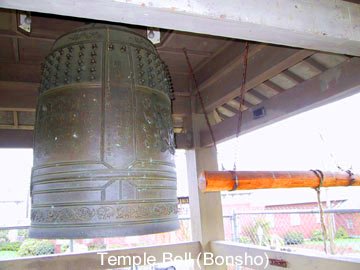Common Terms
Amida Buddha
Amida Buddha (阿弥陀仏, Sanskrit: Amitābha) is the Buddha of Immeasurable Light and the principal Buddha in Pure Land Buddhism. Amida Buddha vowed to create a Pure Land (浄土, Jōdo) where all beings would be born into enlightenment.
Bonshō

The Bonshō (梵鐘) is the large temple bell housed across the street from our temple. The Bonshō is traditionally rung prior to the start of service to let the Sangha (congregation) know that the service will begin shortly.
Dharma Talk
The Dharma Talk, or Howa (法話) is a message typically delivered by the head minister sharing an appreciation of the Buddha Dharma. Through one of the primary Jodo Shinshu practices of deep listening, those hearing the talk reflect upon their lives and learn about the Buddha Nature and Bombu, the common condition of ordinary beings.
Gassho
Gassho (合掌, “joined palms”) is the act of putting our hands together. It signifies the oneness of Buddha and all beings, expressing reverence and gratitude. The palms are placed together and held at a 45-degree angle close to the chest with the Onenju beads encircling both hands.
Gatha
Gathas are the teachings of a Buddha (or commentaries) written in verse form and sung.
Hondō
The hondō (本堂,”Main Hall”) is the primary worship area of temple. The hondō is divided into the gejin (外陣, “Outer area”) seating area and naijin.
Kanshō
In the Jōdo Shinshū tradition, the Kanshō (喚鐘) is often referred to as the Gyoji-sho or “ritual bell” because it is rung just prior to the beginning of a ritual or service. The kanshō hangs inside the temple, behind the naijin.
Naijin
A symbolic representation of the Pure Land, the raised area at the front of the Hondo is the naijin (内陣, “Inner Area”). Here are the main objects of reverence, with a statue of the Amida Buddha in the center, flanked by scrolls of Shinran Shōnin (founder of the Jōdo Shinshū school of Buddhism) and Rennyo Shōnin.
Nembutsu
Recitation of the Nembutsu (念仏), “Na Man Da Bu/Namo Amida Butsu/南無阿弥陀仏” can be translated as “I take refuge in Amida Buddha,” and is one of the central practices of Jōdo Shinshū Buddhism.
Onenju/Ojuzu
Onenju (お念珠, “thought beads”), sometimes called Ojuzu (お数珠), are a loop of beads used during services. Three larger beads represent the Three Treasures of Buddha, Dharma and Sangha. A full strand of onenju has 108 beads, symbolizing the 108 human passions. The onenju encircles the hand during gassho symbolizing Oneness.
Oshoko
Originally incense was burned as a symbolic gesture of cleansing before approaching a person or object of reverence. Offering oshoko (お焼香) at one of the incense burners at the front of the Hondō symbolizes the extinction of impure thoughts and the transiency of all existence.,
Raihai
Performed from a standing or sitting position, raihai (礼拝) is a bow from the waist to a 45 degree angle, often before performing oshoko or with hands held in gassho and reciting the nembutsu.
Sutra
The central practice of almost every service is the chanting of a sutra. Sutras are selected sections of canonical scripture attributed to a Buddha or Buddhist master. During most services, one of the following sutras will be chanted: Jūseige (重誓偈), an excerpt from the Larger Sūtra of Immeasurable Life (仏説無量寿経); Sanbutsuge (讃仏偈, “Praises of the Buddha”) also excerpted from the Larger Sūtra of Immeasurable Life; or Shōshinge, or Shōshin Nembutsu Ge (正信念仏偈), meaning “Gāthā on the Right Faith in Nembutsu,” an exposition of the Pure Land teachings.
Three Treasures
The Three Treasures of Buddhism are the Buddha (an enlightened person), the Dharma (the body of truth a Buddha becomes enlightened to), and the Sangha (the community that tries to live its life based on the Buddha’s teaching).
